Barriers Involved in the Safety Management Systems: A Systematic Review of Literature
Abstract
:1. Introduction
2. Bibliometrics and Research Mapping on Issues of Safety Barriers
2.1. Dataset Preparation
2.2. Distribution of Authors and Affiliations
2.3. Scientific Production and Citations
2.4. Sources Analysis
2.5. Thematic Analysis
3. Advances Focused on Safety Barriers
3.1. Topic 1: Barriers at the Individual Level
3.1.1. Principal Concepts to Describe Safety Barriers
3.1.2. Performance Indicators for Safety Barrier Evaluation
3.1.3. Modeling Methodologies for Safety Barriers
- (1)
- Modeling safety barrier performance evaluation
- (2)
- Modeling safety barrier degradation
3.2. Topic 2: Barrier Management Level
3.2.1. Basic Principles of Barrier Management Systems
- (1)
- Barrier elements
- (2)
- Barrier management system
- (3)
- Barrier management evaluation
3.2.2. Typical Application of Barrier Management Projects in Practice
- (1)
- Accidental risk assessment methodology for industry projects.
- (2)
- The barrier management project launched by DNV GL.
- (3)
- Standards (generic and industry) and guidelines associated with barrier management.
3.2.3. Issues Discussed for Barrier Management
- (1)
- Issue 1: Lack of clear clarification for the boundary of safety barriers
- (2)
- Issue 2: Role of human or organizational barrier elements in barrier management
- (3)
- Issue 3: Integrating various safety barriers into existing safety management
- (4)
- Issue 4: Dynamic assessment of barrier elements based on a system perspective
4. Future Research on Safety Barriers
4.1. Correlation and Synergism of Different Safety Barriers within a Complex Socio-Technical System
4.2. Allocation of Safety Barriers within the Framework of “Risk Capacity”
4.3. Response to Challenges Stemming from Industry 4.0 and Intelligence
4.4. Resilience Theory to Enhance Barrier Management
5. Conclusions
Author Contributions
Funding
Institutional Review Board Statement
Informed Consent Statement
Data Availability Statement
Conflicts of Interest
References
- Möller, N.; Hansson, S.O. Principles of engineering safety: Risk and uncertainty reduction. Reliab. Eng. Syst. Saf. 2008, 93, 798–805. [Google Scholar] [CrossRef]
- Utne, I.B.; Schjølberg, I.; Roe, E. High reliability management and control operator risks in autonomous marine systems and operations. Ocean. Eng. 2019, 171, 399–416. [Google Scholar] [CrossRef]
- Ventikos, N.P.; Chmurski, A.; Louzis, K. A systems-based application for autonomous vessels safety: Hazard identification as a function of increasing autonomy levels. Saf. Sci. 2020, 131, 104919. [Google Scholar] [CrossRef]
- Perrow, C. Normal Accidents: Living with High Risk Technologies-Updated Edition; Princeton University Press: Princeton, NJ, USA, 2011. [Google Scholar]
- Bjerga, T.; Aven, T.; Zio, E. Uncertainty treatment in risk analysis of complex systems: The cases of STAMP and FRAM. Reliab. Eng. Syst. Saf. 2016, 156, 203–209. [Google Scholar] [CrossRef]
- Viertola, J.; Storgård, J. Overview on the Cost-effectiveness of Maritime Safety Policy Instruments. University of Turku, the Centre for Maritime Studies. 2013. Available online: https://urn.fi/URN:ISBN:978-951-29-5480-3 (accessed on 20 July 2022).
- Zhen, X.; Han, Y.; Huang, Y. Optimization of preventive maintenance intervals integrating risk and cost for safety critical barriers on offshore petroleum installations. Process. Saf. Environ. 2021, 152, 230–239. [Google Scholar] [CrossRef]
- Puisa, R.; McNay, J.; Montewka, J. Maritime safety: Prevention versus mitigation? Saf. Sci. 2021, 136, 105151. [Google Scholar] [CrossRef]
- Sklet, S. Hydrocarbon releases on oil and gas production platforms: Release scenarios and safety barriers. J. Loss Prev. Process Ind. 2006, 19, 481–493. [Google Scholar] [CrossRef]
- Sobral, J.; Soares, C.G. Assessment of the adequacy of safety barriers to hazards. Saf. Sci. 2019, 114, 40–48. [Google Scholar] [CrossRef]
- Haddon, W. The Prevention of Accidents. In Preventive Medicine; Little Brown: Boston, MA, USA, 1966. [Google Scholar]
- Gibson, J.J. The contribution of experimental psychology to formulation of problem of safety-A brief for basic research. Behav. Approaches Accid. Res. 1961, 1, 77–89. [Google Scholar]
- Taylor, R.J. Analysemetoder til Vurdering af Våbensikkerhed; Institute for Technical Systems Analysis: Glumsø, Denmark, 1988. [Google Scholar]
- Reason, J. Managing the Risks of Organizational Accidents; Ashgate Publishing Company: Burlington, NJ, USA, 1997. [Google Scholar]
- Delvosalle, C.; Fievez, C.; Pipart, A.; Debray, B. ARAMIS project: A comprehensive methodology for the identification of reference accident scenarios in process industries. J. Hazard. Mater. 2006, 130, 200–219. [Google Scholar] [CrossRef] [PubMed]
- Øie, S.; Wahlstrøm, A.M.; Fløtaker, H.; Rørkær, S. Good Practices—Barrier Management in Operation for the Rig Industry; DNV GL: Byrum, Norway, 2014. [Google Scholar]
- Bubbico, R.; Lee, S.; Moscati, D.; Paltrinieri, N. Dynamic assessment of safety barriers preventing escalation in offshore Oil&Gas. Saf. Sci. 2020, 121, 319–330. [Google Scholar] [CrossRef]
- Landucci, G.; Argenti, F.; Tugnoli, A.; Cozzani, V. Quantitative assessment of safety barrier performance in the prevention of domino scenarios triggered by fire. Reliab. Eng. Syst. Saf. 2015, 143, 30–43. [Google Scholar] [CrossRef]
- Xing, J.; Zeng, Z.; Zio, E. Joint optimization of safety barriers for enhancing business continuity of nuclear power plants against steam generator tube ruptures accidents. Reliab. Eng. Syst. Safe. 2020, 202, 107067. [Google Scholar] [CrossRef]
- King, T.; Van Welter, C.V.; Svensen, T.E. Stability barrier management for large passenger ships. Ocean. Eng. 2016, 125, 342–348. [Google Scholar] [CrossRef]
- Misuri, A.; Landucci, G.; Cozzani, V. Assessment of risk modification due to safety barrier performance degradation in Natech events. Reliab. Eng. Syst. Saf. 2021, 212, 107634. [Google Scholar] [CrossRef]
- Szymanek, A. “Defence-in-Depth” strategy in transport risk management. Communications in Computer and Information Science. In Proceedings of the 10th Conference on Transport Systems Telematics, Katowice Ustron, Poland, 20–23 October 2010. [Google Scholar]
- Debray, B.; Salvi, O. ARAMIS Project: An Integrated Risk Assessment Methodology that Answers the Needs of Various Stakeholders. In Proceedings of the 1st International Conference on Safety and Security Engineering, Rome, Italy, 13–15 June 2005. [Google Scholar]
- PSA. Regulations Relating to Management and the Duty to Provide Information in the Petroleum Activities and at Certain Onshore Facilities; Petroleum Safety Authority: Stavanger, Norway, 2011. [Google Scholar]
- Bucelli, M.; Paltrinieri, N.; Landucci, G.; Cozzani, V. Safety barrier management and risk assessment: Integration for safer operation in the oil and gas industry. In Proceedings of the HAZARDS 27, Birmingham, UK, 10–12 May 2017; Symposium series No. 162; IChemE: Rugby, UK, 2017. [Google Scholar]
- Gomez-Mares, M.; Tugnoli, A.; Landucci, G.; Cozzani, V. Performance Assessment of Passive Fire Protection Materials. Ind. Eng. Chem. Res. 2012, 51, 7679–7689. [Google Scholar] [CrossRef]
- Liu, Y. Safety barriers: Research advances and new thoughts on theory, engineering and management. J. Loss Prev. Process Ind. 2020, 67, 104260. [Google Scholar] [CrossRef]
- Li, J.; Reniers, G.; Cozzani, V.; Khan, F. A bibliometric analysis of peer-reviewed publications on domino effects in the process industry. J. Loss Prev. Process Ind. 2017, 49, 103–110. [Google Scholar] [CrossRef]
- Modak, N.; Merigó, J.M.; Weber, R.; Manzor, F.; Ortúzar, J.D.D. Fifty years of transportation research journals: A bibliometric overview. Transport. Res. A-Pol. 2019, 120, 188–223. [Google Scholar] [CrossRef]
- van Nunen, K.; Li, J.; Reniers, G.; Ponnet, K. Bibliometric analysis of safety culture research. Saf. Sci. 2017, 108, 248–258. [Google Scholar] [CrossRef]
- Xie, L.; Lundteigen, M.A.; Liu, Y.L. Safety barriers against common cause failure and cascading failures: A review and pilot analysis. In Proceedings of the 28th Annual International European Safety and Reliability Conference (ESREL), Trondheim, Norway, 17–21 June 2018. [Google Scholar]
- Bellamy, L.; Ale, B.; Whiston, J.; Mud, M.; Baksteen, H.; Hale, A.; Papazoglou, I.; Bloemhoff, A.; Damen, M.; Oh, J. The software tool storybuilder and the analysis of the horrible stories of occupational accidents. Saf. Sci. 2008, 46, 186–197. [Google Scholar] [CrossRef]
- Lenoble, C.; Durand, C. Introduction of frequency in France following the AZF accident. J. Loss Prev. Process Ind. 2011, 24, 227–236. [Google Scholar] [CrossRef] [Green Version]
- Duijm, N.J.; Markert, F. Safety-barrier diagrams as a tool for modelling safety of hydrogen applications. Int. J. Hydrog. Energy. 2009, 34, 5862–5868. [Google Scholar] [CrossRef]
- Sklet, S. Safety barriers: Definition, classification, and performance. J. Loss Prev. Process Ind. 2006, 19, 494–506. [Google Scholar] [CrossRef]
- Borovinšek, M.; Vesenjak, M.; Ulbin, M.; Ren, Z. Simulation of crash tests for high containment levels of road safety barriers. Eng Fail. Anal. 2007, 14, 1711–1718. [Google Scholar] [CrossRef]
- Dianous, V.; Fievez, C. ARAMIS project: A more explicit demonstration of risk control through the use of bow-tie diagrams and the evaluation of safety barrier performance. J. Hazard. Mater. 2006, 130, 220–233. [Google Scholar] [CrossRef] [Green Version]
- Aven, T.; Sklet, S.; Vinnem, J.E. Barrier and operational analysis of hydrocarbon releases (BORA-release): Part I method description. J. Hazard. Mater. 2006, 137, 692–708. [Google Scholar] [CrossRef]
- Salvi, O.; Debray, B. A global view on ARAMIS, a risk assessment methodology for industries in the framework of the SEVESO II directive. J. Hazard. Mater. 2006, 130, 187–199. [Google Scholar] [CrossRef]
- Rathnayakaa, S.; Khan, F.; Amyotte, P. SHIPP methodology: Predictive accident modeling approach. Part II. Validation with case study. Process. Saf. Environ. 2011, 89, 75–88. [Google Scholar] [CrossRef]
- Kurtuluş, E.; Yildiz, A.R.; Sait, S.M.; Bureerat, S. A novel hybrid Harris hawks- simulated annealing algorithm and RBF-based metamodel for design optimization of highway guardrails. Mater. Test. 2020, 62, 251–260. [Google Scholar] [CrossRef]
- Ren, Z.; Vesenjak, M. Computational and experimental crash analysis of the road safety barrier. Eng. Fail. Anal. 2005, 12, 963–973. [Google Scholar] [CrossRef]
- Yeo, C.T.; Bhandari, J.; Abbassi, R. Dynamic risk analysis of offloading process in floating liquefied natural gas (FLNG) platform using Bayesian Network. J. Loss Prev. Process Ind. 2016, 41, 259–269. [Google Scholar] [CrossRef]
- Von Eck, N.J.; Waltman, L. Visualizing Bibliometric Networks, in: Measuring Scholarly Impact: Methods and Practice; Springer: New York, NY, USA, 2014. [Google Scholar]
- Chen, C.; Reniers, G.; Khakzad, N. Integrating safety and security resources to protect chemical industrial parks from man-made domino effects: A dynamic graph approach. Rellab. Eng. Syst. Saf. 2019, 191, 106470. [Google Scholar] [CrossRef]
- Bucelli, M.; Landucci, G.; Haugen, S.; Paltrinieri, N.; Cozzani, V. Assessment of safety barriers for the prevention of cascading events in oil and gas offshore installations operating in harsh environment. Ocean Eng. 2018, 158, 171–185. [Google Scholar] [CrossRef]
- Moreno, V.C.; Guglielmi, D.; Cozzani, V. Identification of critical safety barriers in biogas facilities. Reliab. Eng. Syst. Saf. 2018, 169, 81–94. [Google Scholar] [CrossRef]
- Sule, I.; Khan, F.; Butt, S.; Yang, M. Kick control reliability analysis of managed pressure drilling operation. J. Loss Prev. Process Ind. 2018, 52, 7–20. [Google Scholar] [CrossRef]
- Landucci, G.; Argenti, F.; Spadoni, G.; Cozzani, V. Domino effect frequency assessment: The role of safety barriers. J. Loss Prev. Process Ind. 2016, 44, 706–717. [Google Scholar] [CrossRef]
- Mcleod, R.W. Human factors in barrier management: Hard truths and challenges. Process. Saf. Environ. 2017, 110, 31–42. [Google Scholar] [CrossRef]
- Behie, S.W.; Halim, S.Z.; Efaw, B.; O’Connor, T.M.; Quddus, N. Guidance to improve the effectiveness of process safety management systems in operating facilities. J. Loss Prev. Process Ind. 2020, 68, 104257. [Google Scholar] [CrossRef] [PubMed]
- Cattaneo, S.; Crespi, P.; Biolzi, L. Structural Analysis and Design of Reinforced Concrete Bridge Corbels. Appl. Sci. 2020, 10, 6727. [Google Scholar] [CrossRef]
- Dinnella, N.; Chiappone, S.; Guerrieri, M. The innovative “NDBA” concrete safety barrier able to withstand two subsequent TB81 crash tests. Eng. Fail. Anal. 2020, 115, 104660. [Google Scholar] [CrossRef]
- Meda, A.; Rinaldi, Z.; Spagnuolo, S.; Grecco, R. Full-cale tests on bridge kerbs subjected to horizontal actions. Struct. Concr. 2020, 22, 813–826. [Google Scholar] [CrossRef]
- Haddon, W. Energy damage and the ten countermeasure strategies. Hum. Factors 1973, 15, 355–366. [Google Scholar] [CrossRef] [PubMed] [Green Version]
- Harms-Ringdahl, L. Analysis of safety functions and barriers in accidents. Saf. Sci. 2009, 47, 353–363. [Google Scholar] [CrossRef] [Green Version]
- CCPS. Layer of Protection Analysis: Simplified Process Risk Assessment; Center of Chemical Process Safety; American Institute of Chemical Engineers: New York, NY, USA, 2001. [Google Scholar]
- IEC 61508. Functional Safety of Electrical/Electronic/Programmable Electronic Safety-Related Systems—Part 5: Examples of Methods for the Determination of Safety Integrity Levels, 2nd ed.; International Electrotechnical Commission: Geneva, Switzerland, 2010. [Google Scholar]
- Torres-Echeverria, A.C. On the use of LOPA and risk graphs for SIL determination. J. Loss Prev. Process Ind. 2016, 41, 333–343. [Google Scholar] [CrossRef]
- Xue, L.; Fan, J.; Rausand, M.; Zhang, L. A safety barrier-based accident model for offshore drilling blowouts. J. Loss Prev. Process Ind. 2013, 26, 164–171. [Google Scholar] [CrossRef]
- Rausand, M. Risk Assessment: Theory, Methods and Applications; John Wiley & Sons: Hoboken, NJ, USA, 2011. [Google Scholar]
- PSA. Principles for Barrier Management in the Petroleum Industry; Petroleum Safety Authority Norway: Stavanger, Norway, 2013. [Google Scholar]
- Badreddine, A.; Romdhane, T.B.; Hajkacem, M.A.B. A new multi-objectives approach to implement preventive and protective barriers in bow tie diagram. J. Loss Prev. Process Ind. 2014, 32, 238–253. [Google Scholar] [CrossRef]
- Kang, J.; Zhang, J.; Gao, J. Analysis of the safety barrier function: Accidents caused by the failure of safety barriers and quantitative evaluation of their performance. J. Loss Prev. Process Ind. 2016, 43, 361–371. [Google Scholar] [CrossRef]
- Misuri, A.; Landucci, G.; Cozzani, V. Assessment of safety barrier performance in the mitigation of domino scenario caused by Natech events. Reliab. Eng. Syst. Saf. 2021, 205, 107278. [Google Scholar] [CrossRef]
- Hollnagel, E. Risk+barriers=safety? Saf. Sci. 2008, 46, 221–229. [Google Scholar] [CrossRef]
- Ersdal, G. Safety Barriers in Structural and Marine Engineering. In Proceedings of the ASME 2017 36th International Conference on Ocean, Offshore and Arctic Engineering, Trondheim, Norway, 25–30 June 2017. [Google Scholar]
- ISO 13702; Petroleum and Natural Gas Industries—Control and Mitigation of Fires and Explosions on Offshore Production Installations—Requirements and Guidelines. The Spanish Association for Standardization and Certification: Madrid, Spain, 2015.
- Pitblado, R.; Fisher, M.; Nelson, B.; Fløtaker, H.; Molazemi, K.; Stokke, A. Concept for dynamic barrier management. J. Loss Prev. Process Ind. 2016, 43, 741–746. [Google Scholar] [CrossRef]
- Rausand, M. Reliability of Safety-Critical Systems: Theory and Applications; John Wiley & Sons: Hoboken, NJ, USA, 2014. [Google Scholar]
- Janssens, J.; Talarico, L.; Reniers, G.; Sörensen, K. A decision model to allocate protective safety barriers and mitigate domino effects. Reliab. Eng. Syst. Saf. 2015, 143, 44–52. [Google Scholar] [CrossRef]
- Johansen, I.L.; Rausand, M. Barrier management in the offshore oil and gas industry. J. Loss Prev. Process Ind. 2015, 34, 49–55. [Google Scholar] [CrossRef]
- Prashanth, G.J.; Fernandez, R.G.; Sunder, B. Boardman. Factors influencing safety barrier performance for onshore gas drilling operations. J. Loss Prev. Process Ind. 2017, 49, 291–298. [Google Scholar] [CrossRef]
- Dimaiof; Scapinello, O.; Zio, E.; Ciarapica, C.; Cincotta, S.; Crivellari, A.; Decarli, L.; Larosa, L. Accounting for Safety Barriers Degradation in the Risk Assessment of Oil and Gas Systems by Multistate Bayesian Networks. Reliab. Eng. Syst. Saf. 2021, 216, 107943. [Google Scholar] [CrossRef]
- Mirderikvand, H.; Razavian, F.; Nakhaee, A.; Ghiasabadi, B.M.; Gholamnia, R. A barrier risk-based evaluation model for drilling blowouts. J. Loss Prev. Process Ind. 2021, 74, 104624. [Google Scholar] [CrossRef]
- Misuri, A.; Landucci, G.; Cozzani, V. Assessment of safety barrier performance in Natech scenarios. Reliab. Eng. Syst. Saf. 2020, 193, 106597. [Google Scholar] [CrossRef]
- Couronneau, J.C.; Tripathi, A. Implementation of the New Approach of Risk Analysis in France. In Proceedings of the 41st International Petroleum Conference, Bratislava, Slovakia, 3–5 October 2003. [Google Scholar]
- Khakzad, N.; Landucci, G.; Reniers, G. Application of graph theory to cost-effective fire protection of chemical plants during domino effects. Risk Anal. 2017, 37, 1652–1667. [Google Scholar] [CrossRef]
- Shahrokhi, M.; Bernard, A. A development in energy flow/barrier analysis. Saf. Sci. 2010, 48, 598–606. [Google Scholar] [CrossRef]
- Landucci, G.; Bonvicini, S.; Cozzani, V. A methodology for the analysis of domino and cascading events in Oil & Gas facilities operating in harsh environments. Saf. Sci. 2017, 95, 182–197. [Google Scholar] [CrossRef]
- Necci, A.; Antonioni, G.; Cozzani, V.; Krausmann, E.; Borghetti, A.; Nucci, C.A. Assessment of lightning impact frequency for process equipment. Reliab. Eng. Syst. Saf. 2014, 130, 95–105. [Google Scholar] [CrossRef]
- IEC 61508; Functional Safety of Electrical/Electronic/Programmable Electronic Safety-Related Systems-Part 2: Requirements for Electrical/Electronic/Programmable Electronic Safety-Related Systems. International Electrotechnical Commission: Geneva, Switzerland, 2010.
- IEC 61511; Functional Safety—Safety Instrumented Systems for the Process Industry Sector-Part 3: Guidance for the Determination of the Required Safety Integrity Levels. International Electrotechnical Commission: Geneva, Switzerland, 2016.
- Gao, X.; Barabady, J.; Markeset, T. An approach for prediction of petroleum production facility performance considering Arctic influence factors. Reliab. Eng. Syst. Saf. 2010, 95, 837–846. [Google Scholar] [CrossRef]
- IEC 61508; Functional Safety of Electrical/Electronic/Programmable Electronic Safety-Related Systems-Part 1: General Requirements. International Electrotechnical Commission: Geneva, Switzerland, 2010.
- Madonna, M.; Martella, G.; Monica, L.; Maini, E.P.; Tomassini, L. The human factor in risk assessment: Methodological comparison between human reliability analysis techniques. Prev. Today 2009, 5, 67–83. [Google Scholar]
- Dowell, A.M.; Dennis, C. Hendershot. In Simplified risk analysis: Layer of protection analysis (LOPA). In Proceedings of the AIChE 2002 National Meeting, Indianapolis, IN, USA, 3–8 November 2002. [Google Scholar]
- IEC 61511; Functional Safety—Safety Instrumented Systems for the Industry Sector-Part 2: Guidelines for the application. International Electrotechnical Commission: Geneva, Switzerland, 2001.
- Landucci, G.; Necci, A.; Antonioni, G.; Argenti, F.; Cozzani, V. Risk assessment of mitigated domino scenarios in process facilities. Reliab. Eng. Syst. Saf. 2017, 160, 37–53. [Google Scholar] [CrossRef]
- Villa, V.; Paltrinieri, N.; Khan, F.; Cozzani, V. Towards dynamic risk analysis: A review of the risk assessment approach and its limitations in the chemical process industry. Saf. Sci. 2016, 89, 77–93. [Google Scholar] [CrossRef]
- Aneziris, O.N.; Nivolianitou, Z.; Konstandinidou, M. A Total Safety Management framework in case of a major hazards plant producing pesticides. Saf. Sci. 2017, 100, 183–194. [Google Scholar] [CrossRef]
- Khakzad, N.; Khan, F.; Amyotte, P. Dynamic safety analysis of process systems by mapping bow-tie into Bayesian network. Process. Saf. Environ. 2013, 91, 46–53. [Google Scholar] [CrossRef]
- Pitblado, R.; Bain, B.; Falck, A.; Litland, K.; Spitzenberger, C. Frequency data and modification factors used in QRA studies. J. Loss Prev. Process Ind. 2011, 24, 249–258. [Google Scholar] [CrossRef]
- Zeng, Z.; Zio, E. Dynamic Risk Assessment Based on Statistical Failure Data and Condition-Monitoring Degradation Data. IEEE Trans. Reliab. 2018, 67, 609–622. [Google Scholar] [CrossRef]
- Xing, J.; Zeng, Z.; Zio, E. A framework for dynamic risk assessment with condition monitoring data and inspection data. Reliab. Eng. Syst. Saf. 2019, 191, 106552. [Google Scholar] [CrossRef] [Green Version]
- Lauridsen, O.; Lootz, E.; Husebo, T.; Ersdal, G. Barrier management and the interaction between technical, operational and organizational barrier elements. In Proceedings of the International Conference and Exhibition on Health, Safety, Security, Environment, and Social Responsibility, Stavanger, Norway, 11 April 2016. [Google Scholar]
- NOG. Deepwater Horizon: Lessons Learned and Follow-up (Technical Report); Norwegian Oil and Gas Association: Stavanger, Norway, 2012. [Google Scholar]
- Kjellen, U. Safety in the design of offshore platforms: Integrated safety versus safety as an add-on characteristic. Saf. Sci. 2007, 45, 107–127. [Google Scholar] [CrossRef]
- PSA. Risk and Risk Understanding. Available online: http://www.psa.no/risk-and-risk-management/category897.html (accessed on 20 July 2022).
- Reason, J. Human Error; Cambridge University Press: New York, NY, USA, 1990. [Google Scholar]
- Cherubin, P.; Pellino, S.; Petrone, A. Baseline risk assessment tool: A comprehensive risk management tool for process safety. Process. Saf. Prog. 2011, 30, 251–260. [Google Scholar] [CrossRef]
- Lanzano, G.; de Magistris, F.S.; Fabbrocino, G.; Salzano, E. Seismic damage to pipelines in the framework of Na-Tech risk assessment. J. Loss Prev. Process Ind. 2015, 33, 159–172. [Google Scholar] [CrossRef]
- Landucci, G.; Necci, A.; Antonioni, G.; Tugnoli, A.; Cozzani, V. Release of hazardous substances in flood events: Damage model for horizontal cylindrical vessels. Reliab. Eng. Syst. Saf. 2014, 132, 125–145. [Google Scholar] [CrossRef]
- Necci, A.; Argenti, F.; Landucci, G.; Cozzani, V. Accident scenarios triggered by lightning strike on atmospheric storage tanks. Reliab. Eng. Syst. Saf. 2014, 127, 30–46. [Google Scholar] [CrossRef]
- Khakzad, N. Application of dynamic Bayesian network to risk analysis of domino effects in chemical infrastructures. Reliab. Eng. Syst. Saf. 2015, 138, 263–272. [Google Scholar] [CrossRef]
- Qiao, W.; Liu, Y.; MA, X.; Liu, Y. A methodology to evaluate human factors contributed to maritime accident by mapping fuzzy FT into ANN based on HFACS. Ocean Eng. 2020, 197, 106892. [Google Scholar] [CrossRef]
- Qiao, W.; Liu, Y.; MA, X.; Liu, Y. Human Factors Analysis for Maritime Accidents Based on a Dynamic Fuzzy Bayesian Network. Risk Anal. 2020, 40, 957–980. [Google Scholar] [CrossRef]
- Ma, X.; Deng, W.; Qiao, W.; Luo, H. A novel methodology concentrating on risk propagation to conduct a risk analysis based on a directed complex network. Risk Anal. 2022, 13870. [Google Scholar] [CrossRef] [PubMed]
- Villemeur, A. Reliability, Availability, Maintainability, and Safety Assessment: Assessment, Hardware, Software, and Human Factors; Wiley: Hoboken, NJ, USA, 1992. [Google Scholar]
- Sklet, S. Comparison of some selected methods for accident investigation. J. Hazard. Mater. 2004, 111, 29–37. [Google Scholar] [CrossRef] [PubMed]
- Targoutzidis, A. Incorporating human factors into a simplified “bow-tie” approach for workplace risk assessment. Saf. Sci. 2010, 48, 145–156. [Google Scholar] [CrossRef]
- Bergan, H.H.; Naseri, M. Well Control Operation in the Arctic Offshore: A Qualitative Risk Model. In Proceedings of the International Conference on Port and Ocean Engineering under Arctic Conditions, Trondheim, Norway, 14–18 June 2015. [Google Scholar]
- de Ruijter, A.; Guldenmund, F. The bowtie method: A review. Saf. Sci. 2016, 88, 211–218. [Google Scholar] [CrossRef]
- CCPS. Guidelines for Bowtie Risk Management; Center for Chemical Process Safety; Wiley: Hoboken, NJ, USA, 2017. [Google Scholar]
- CIEHF. Human Factors in Barrier Management; Chartered Institute of Ergonomics and Human Factors: Loughborough, UK, 2016. [Google Scholar]
- Ramzali, N.; Lavasani, M.; Ghodousi, J. Safety barriers analysis of offshore drilling system by employing Fuzzy Event Tree Analysis. Saf. Sci. 2015, 78, 49–59. [Google Scholar] [CrossRef]
- Tsunemi, K.; Kihara, T.; Kato, E.; Kawamoto, A.; Saburi, T. Quantitative risk assessment of the interior of a hydrogen refueling station considering safety barrier systems. Int. J. Hydrog. Energy. 2019, 44, 23522–23531. [Google Scholar] [CrossRef]
- Sun, F.; Xu, W.; Wang, G.; Sun, B. A technique to control major hazards of the coal gasification process developed from critical events and safety barriers. Process. Saf. Prog. 2017, 36, 382–391. [Google Scholar] [CrossRef]
- Miura, K.; Morooka, C.K.; Mendes, J.R.P.; Guilherme, I.R. Characterization of operational safety in offshore oil wells. J. Pet. Sci. Eng. 2006, 51, 111–126. [Google Scholar] [CrossRef]
- Pitbaldo, R.; Nelson, W.R. Advanced safety barrier management with inclusion of human and organizational aspects. Chem. Eng. J. 2013, 31, 331–336. [Google Scholar] [CrossRef]
- Ade, N.; Peres, S.C. A review of human reliability assessment methods for proposed application in quantitative risk analysis of offshore industries. Int. J. Ind. Ergonom. 2022, 87, 103238. [Google Scholar] [CrossRef]
- Grattan, D.J. Improving barrier effectiveness using human factors methods. J. Loss Prev. Process Ind. 2018, 55, 400–410. [Google Scholar] [CrossRef]
- Vinnem, J.E.; Bye, R.; Gran, B.A.; Kongsvik, T.; Nyheim, O.M.; Okstad, E.H.; Seljelid, J.; Vatn, J. Risk modelling of maintenance work on major process equipment on offshore petroleum installations. J. Loss Prev. Process Ind. 2012, 25, 274–292. [Google Scholar] [CrossRef]
- Detman, D.; Groot, G. Shell’s Experience Implementing a Manual of Permitted Operations. In Proceedings of the 14th Annual Symposium Mary Kay O’Connor Process Safety Center, Texas A&M University, College Station, TX, USA, 5–7 October 2011. [Google Scholar]
- Jackson, N. Cumulative Risk Modeling in BG. In Proceedings of the Piper Alpha 25 Conference, Aberdeen, UK, 18 June 2013. [Google Scholar]
- Refsdal, I.; Østby, E. A Step Change in Managing Technical Integrity in the Oil and Gas Industry—A Case Study. In Proceedings of the Offshore Technical Conference-Asia, Kuala Lumpur, Malaysia, 25–28 March 2014. [Google Scholar]
- Nelson, B. Joint Industry Project—Decision Support for Dynamic Barrier Management; DNV GL: Byrum, Norway, 2015. [Google Scholar]
- Perrin, L.; Munoz-Giraldo, F.; Dufaud, O.; Laurent, A. Normative barriers improvement through the MADS/MOSAR methodology. Saf. Sci. 2012, 50, 1502–1512. [Google Scholar] [CrossRef]
- Li, Y.; Guldenmund, F.W. Safety management systems: A broad overview of the literature. Saf. Sci. 2018, 103, 94–123. [Google Scholar] [CrossRef]
- Duijm, N.J.; Goossens, L. Quantifying the influence of safety management on the reliability of safety barriers. J. Hazard. Mater. 2006, 130, 284–292. [Google Scholar] [CrossRef] [PubMed]
- Hale, A.R.; Guldenmund, F.W.; Bellamy, L.J.; Wilson, C. IRMA: Integrated Risk Management Audit for Major Hazard Sites; Schueller, G.I., Kafka, P., Eds.; Safety & Reliability: Balkema, Rotterdam, The Netherlands, 1999; pp. 1315–1320. [Google Scholar]
- Guldenmund, F.; Hale, A.; Goosens, L.; Betten, J.; Duijm, N.J. The development of an audit technique to assess the quality of safety barrier management. J. Hazard. Mater. 2006, 130, 234–241. [Google Scholar] [CrossRef] [PubMed]
- Duijm, N.J.; Andersen, H.B.; Cleal, B.; Hale, A.R.; Guldenmund, F.W. Development of barrier-oriented audit protocols and safety culture questionnaires: Application to Dutch and Danish test sites. In Proceedings of the 1st International Conference on Safety and Security Engineering, Rome, Italy, 13–15 June 2005. [Google Scholar]
- Bellamy, L.J.; Mud, M.; Damen, M.; Baksteen, H.; Aneziris, O.; Papazoglou, I.; Hale, A.R.; Oh, J.I.H. Which management system failures are responsible for occupational accidents? Saf. Sci. 2010, 14, 1–19. [Google Scholar]
- Planas, E.; Arnaldos, J.; Silvetti, B.; Casal, J. The Assessment of Risk in Industrial Installations: The Risk Severity Index. In Safety and Security Engineering. In Proceedings of the 1st International Conference on Safety and Security Engineering, Rome, Italy, 13–15 June 2005. [Google Scholar]
- NORSOK. S-001 Technical Safety, 4th ed.; Standards Norway: Lysaker, Norway, 2008. [Google Scholar]
- Hauge, S.; Øien, K. Guidance for Barrier Management in the Petroleum Industry; SINTEF: Trondheim, Norway, 2016. [Google Scholar]
- IEC 62061; Safety of Machinery—Functional Safety of Safety-Related Electrical, Electronic and Programmable Electronic Control Systems. International Electrotechnical Commission: Geneva, Switzerland, 2005.
- As/Nzs 3845 1; Road Safety Barrier Systems and Devices—Road Safety Barrier Systems. Standards Australia: Sydney, Australia, 2015.
- EN 50126; Railway Applications—The Specification and Demonstration of Reliability, Availability, Maintainability and Safety (RAMS). CENELEC—European Committee for Electrotechnical Standardization: Brussels, Belgium, 2017.
- ISO 19353; Machine Safety—Preventive Fire Protection and Protection. International Standard Organization: Geneva, Switzerland, 2015.
- ISO 16530; Petroleum and Natural Gas Industries—Well Integrity. International Standard Organization: Geneva, Switzerland, 2017.
- ISO 28781; Petroleum and Natural Gas Industries—Drilling and Production Equipment—Subsurface Barrier Valves and Related Equipment. International Standard Organization: Geneva, Switzerland, 2010.
- PSA. RNNP: Risk Levels in Norwegian Petroleum Activities 2013 (Technical Report); PSA: Stavanger, Norway, 2014. [Google Scholar]
- Markert, F.; Duijma, N.J.; Thommesen, J. Modelling of safety barriers including human and organisational factors to improve process safety. Chem. Eng. Process. 2013, 31, 283–288. [Google Scholar] [CrossRef]
- Gustafson, S. Barrier Management within the Oil and Gas Industry. A Comparison Study of the Implementation and Interpretation of Norway’s and EU’s Regulations with Focus on the Environment. Master’s Thesis, Lund University, Lund, Switzerland, 2014. [Google Scholar]
- CSB. Investigation Report Volume 3: Drilling Rig Explosion and Fire at the Macondo Well; Report no. 2010-10-I-OS; Chemical Safety Board: Washington, DC, USA, 2016. [Google Scholar]
- Paltrinieri, N.; Reniers, G. Dynamic risk analysis for Seveso sites. J. Loss Prev. Process Ind. 2017, 49, 111–119. [Google Scholar] [CrossRef] [Green Version]
- Størseth, F.; Hauge, S.; Tinmannsvik, R. Safety barriers: Organizational potential and forces of psychology. J. Loss Prev. Process Ind. 2014, 31, 50–55. [Google Scholar] [CrossRef]
- Badri, A.; Boudreau-Trudel, B.; Souissi, A.S. Occupational health and safety in the industry 4.0 era: A cause for major concern? Saf. Sci. 2018, 109, 403–411. [Google Scholar] [CrossRef]
- Wang, B. Safety intelligence as an essential perspective for safety management in the era of Safety 4.0: From a theoretical to a practical framework. Process. Saf. Environ. 2021, 148, 189–199. [Google Scholar] [CrossRef]
- Mkhida, A.; Thiriet, J.M.; Aubry, J.F. Integration of intelligent sensors in safety instrumented systems (SIS). Process. Saf. Environ. 2014, 92, 142–149. [Google Scholar] [CrossRef]
- Selvik, J.T.; Abrahamsen, E.B. How to classify failures when collecting data for safety-instrumented systems in the oil and gas industry. J. Risk. Res. 2017, 20, 952–962. [Google Scholar] [CrossRef]
- Agrawal, R.; Verma, A.; Gayen, T. Reliability assessment of safety critical intelligent systems: Issues and challenges. In Proceedings of the Conference on Computational Methods in Systems and Software (CoMeSySo), Vsetin, Czech Republic, 12–14 September 2017. [Google Scholar]
- Qiao, W.; Ma, X.; Liu, Y.; He, L. Resilience Assessment for the Northern Sea Route Based on a Fuzzy Bayesian Network. Appl. Sci. 2021, 11, 3619. [Google Scholar] [CrossRef]
- Aven, T. A risk science perspective on the discussion concerning Safety I, Safety II and Safety III. Reliab. Eng. Syst. Saf. 2022, 217, 108077. [Google Scholar] [CrossRef]
- Qiao, W.; Liu, Y.; Ma, X.; He, L. Cognitive Gap and Correlation of Safety-I and Safety-II: A Case of Maritime Shipping Safety Management. Sustainability 2021, 13, 5509. [Google Scholar] [CrossRef]
- Hollnagel, E. Safety-II in Practice: Developing the Resilience Potentials; Taylor & Francis: Abingdon, UK, 2017. [Google Scholar]
- Ma, L.; Ma, X.; Zhang, J.; Yang, Q.; Wei, K. Identifying the weaker function links in the hazardous chemicals road transportation system in China. Int. J. Environ. Res. Public Health 2021, 18, 7039. [Google Scholar] [CrossRef] [PubMed]
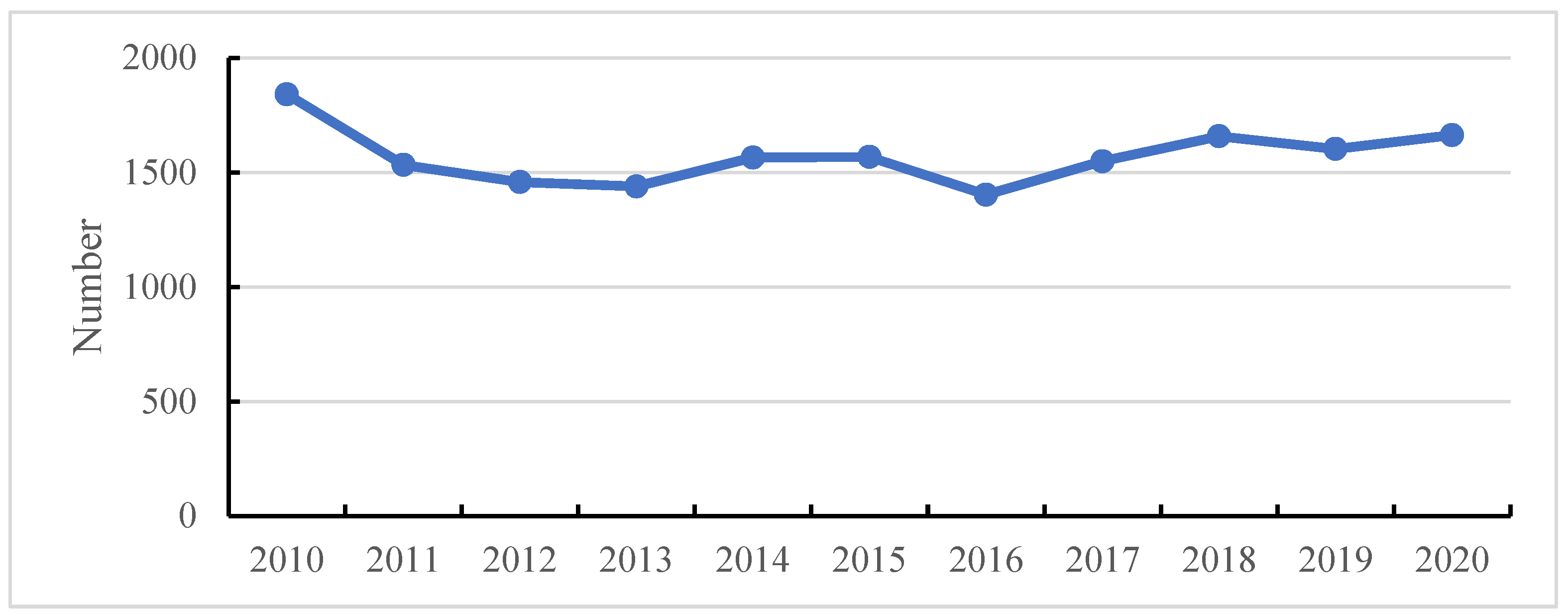
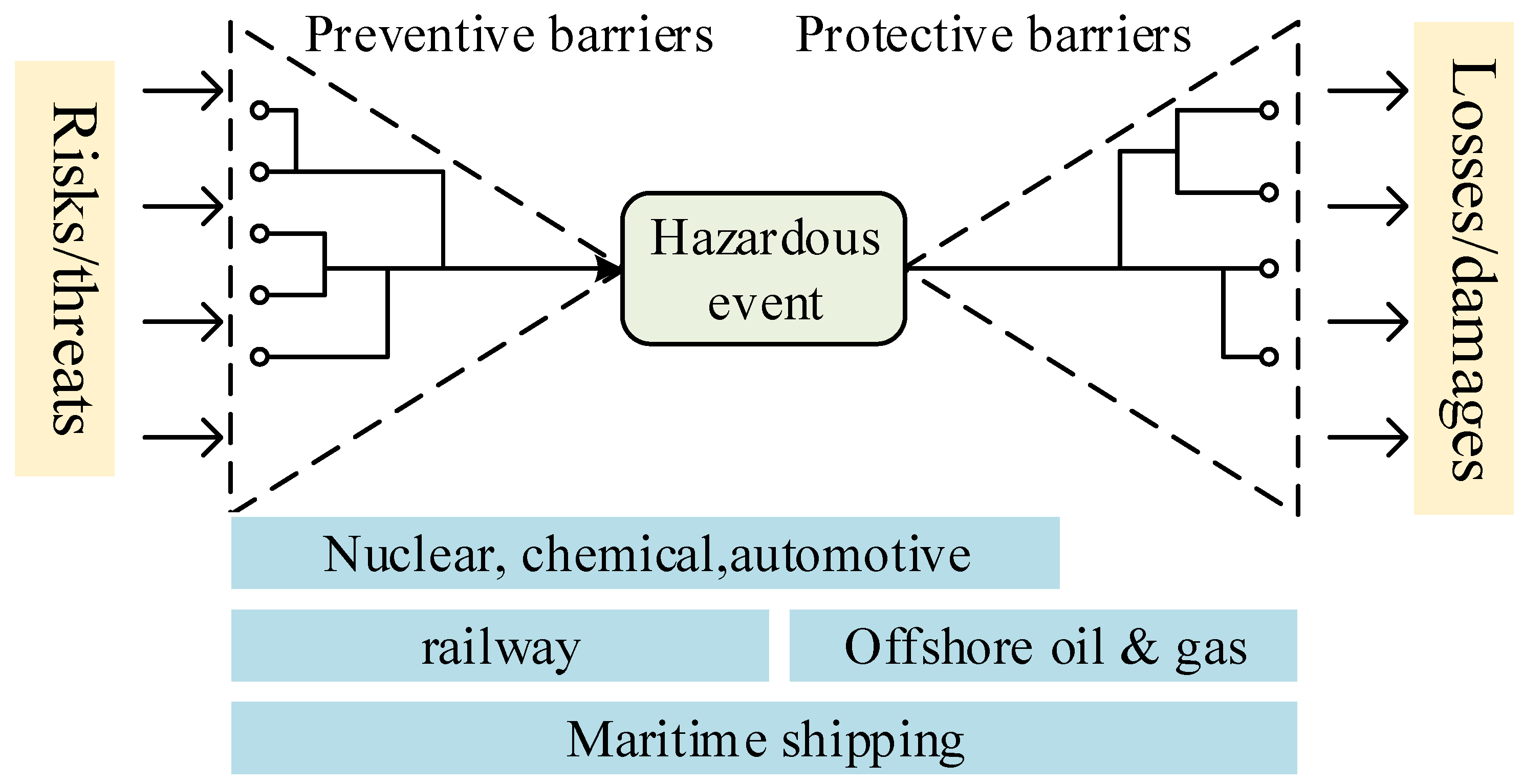
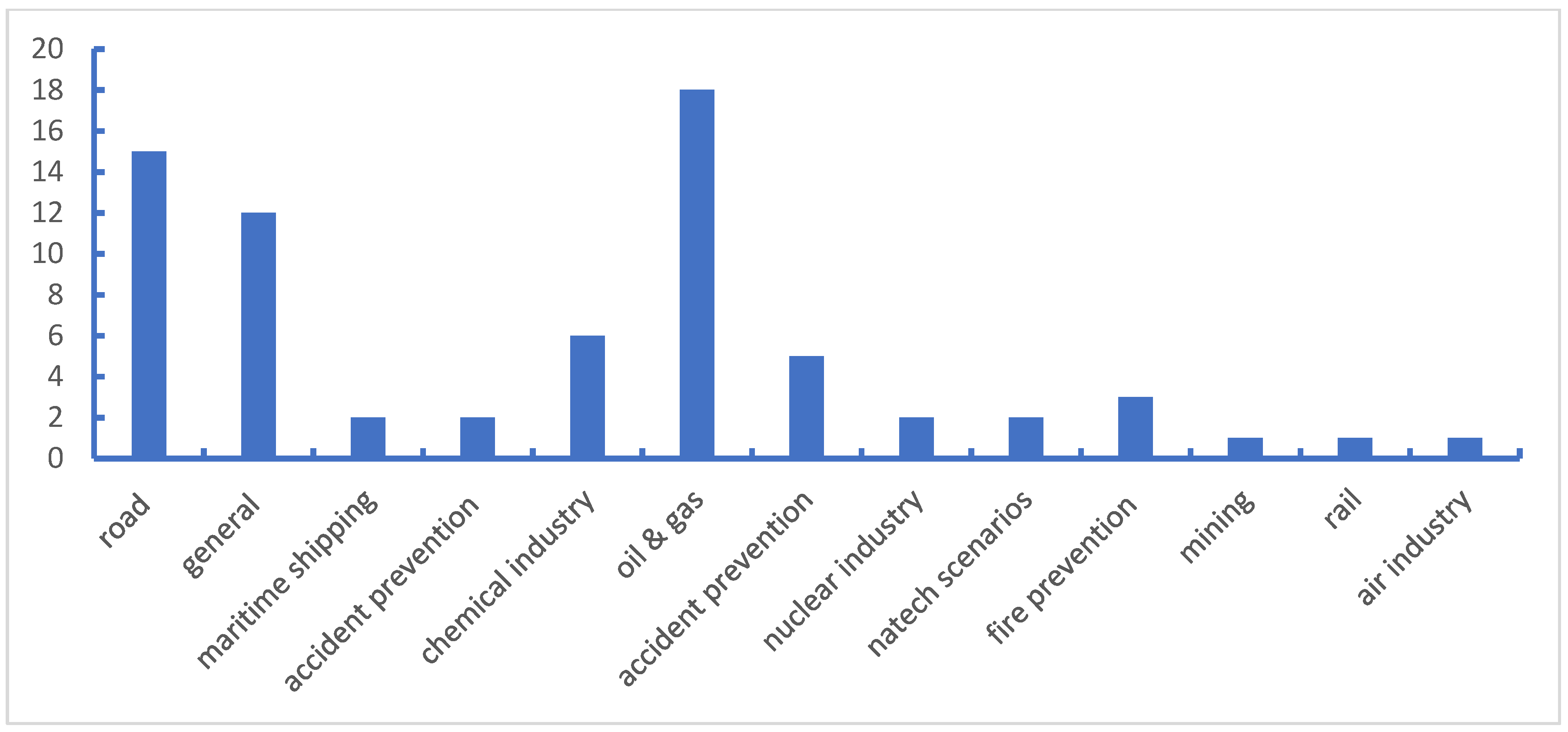
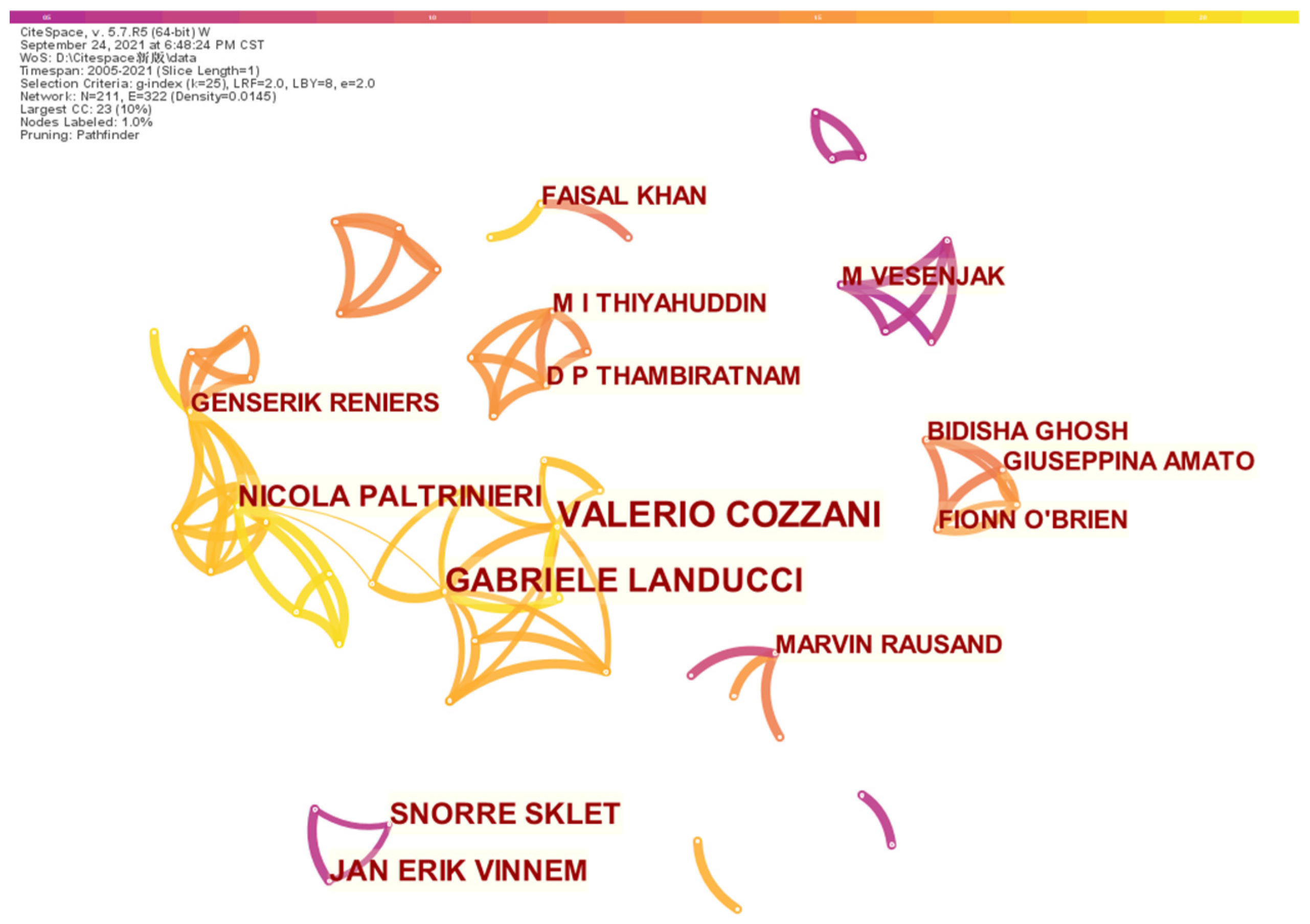

 Publication,
Publication,  citation.
citation.
 Publication,
Publication,  citation.
citation.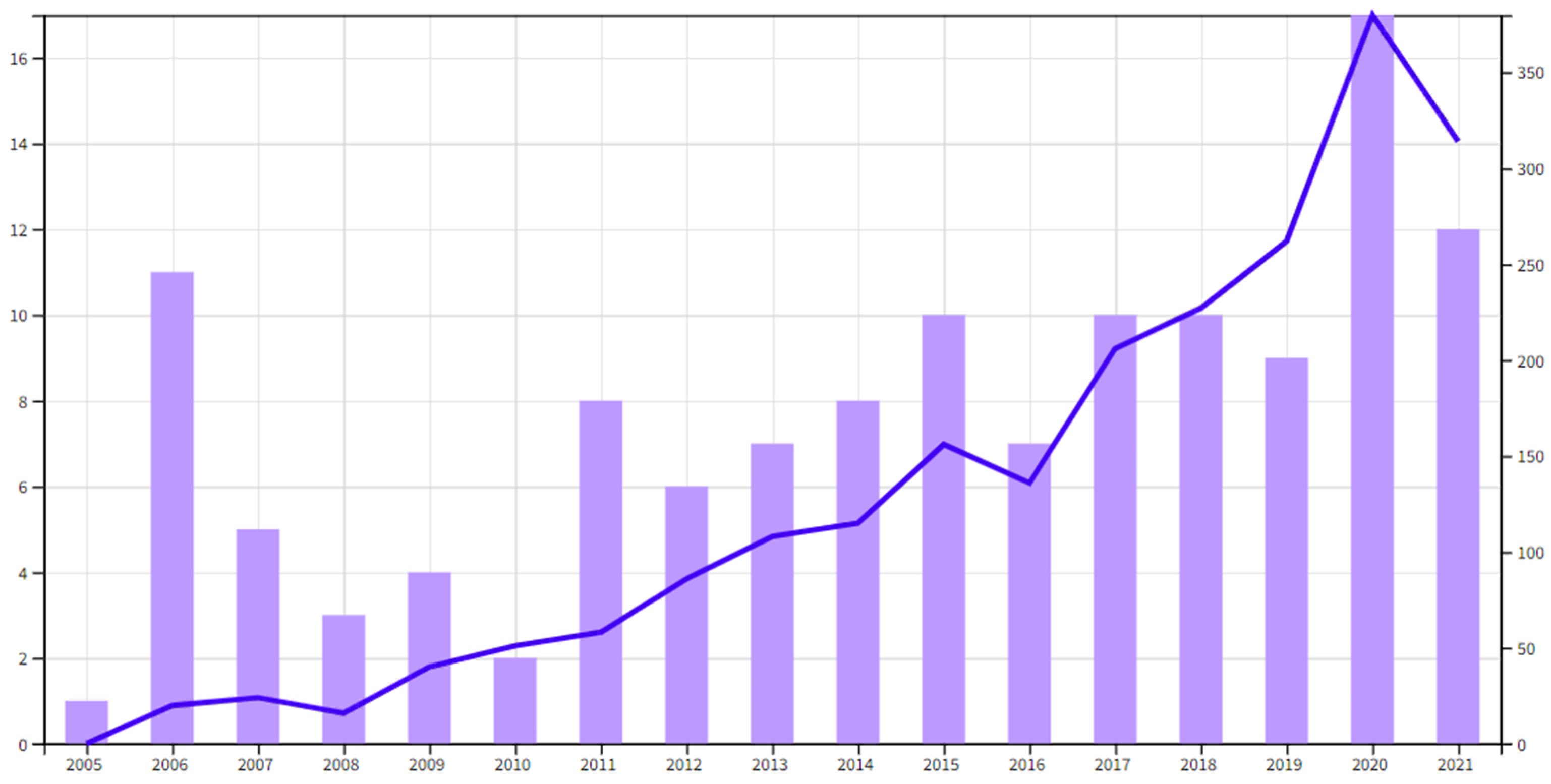


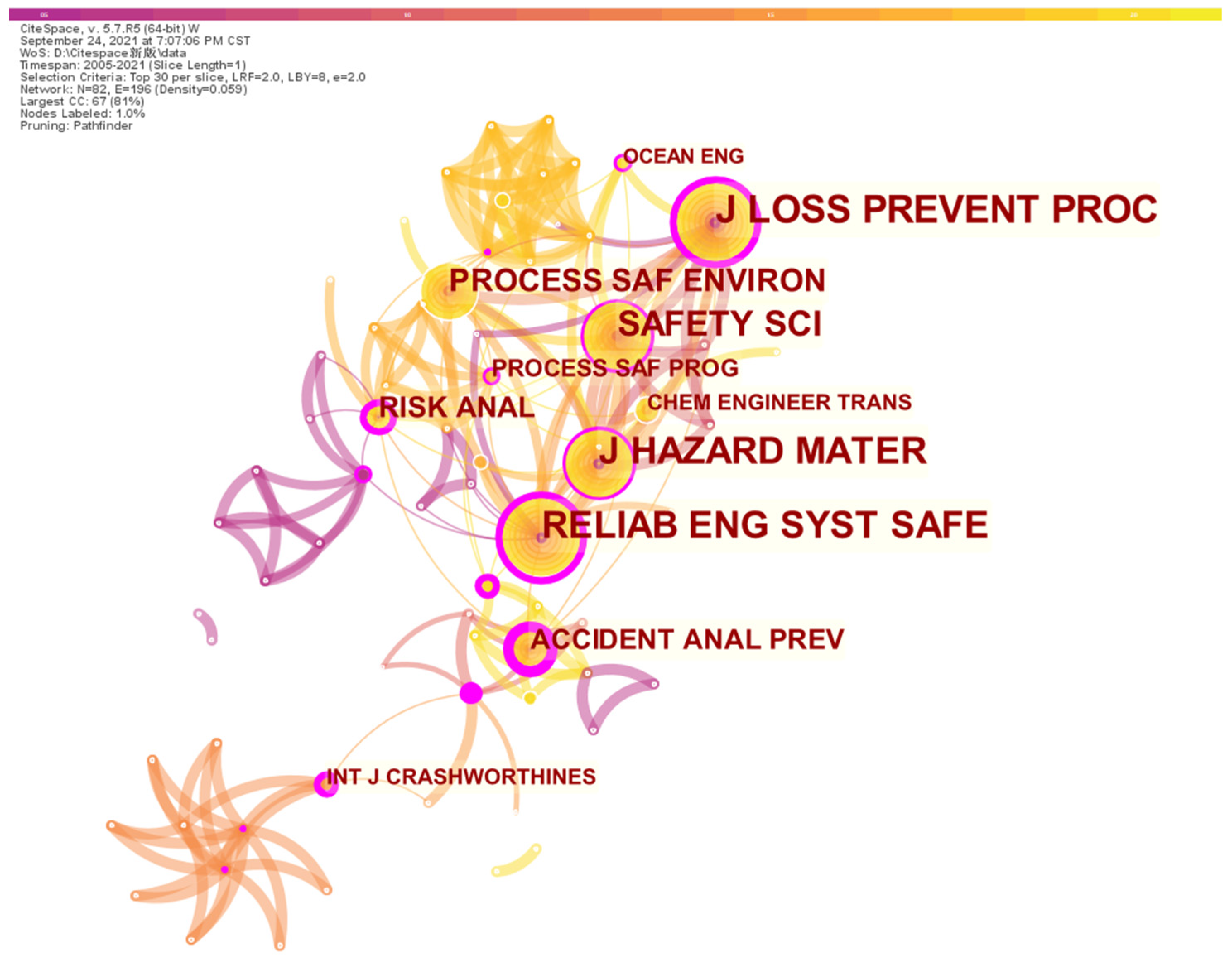

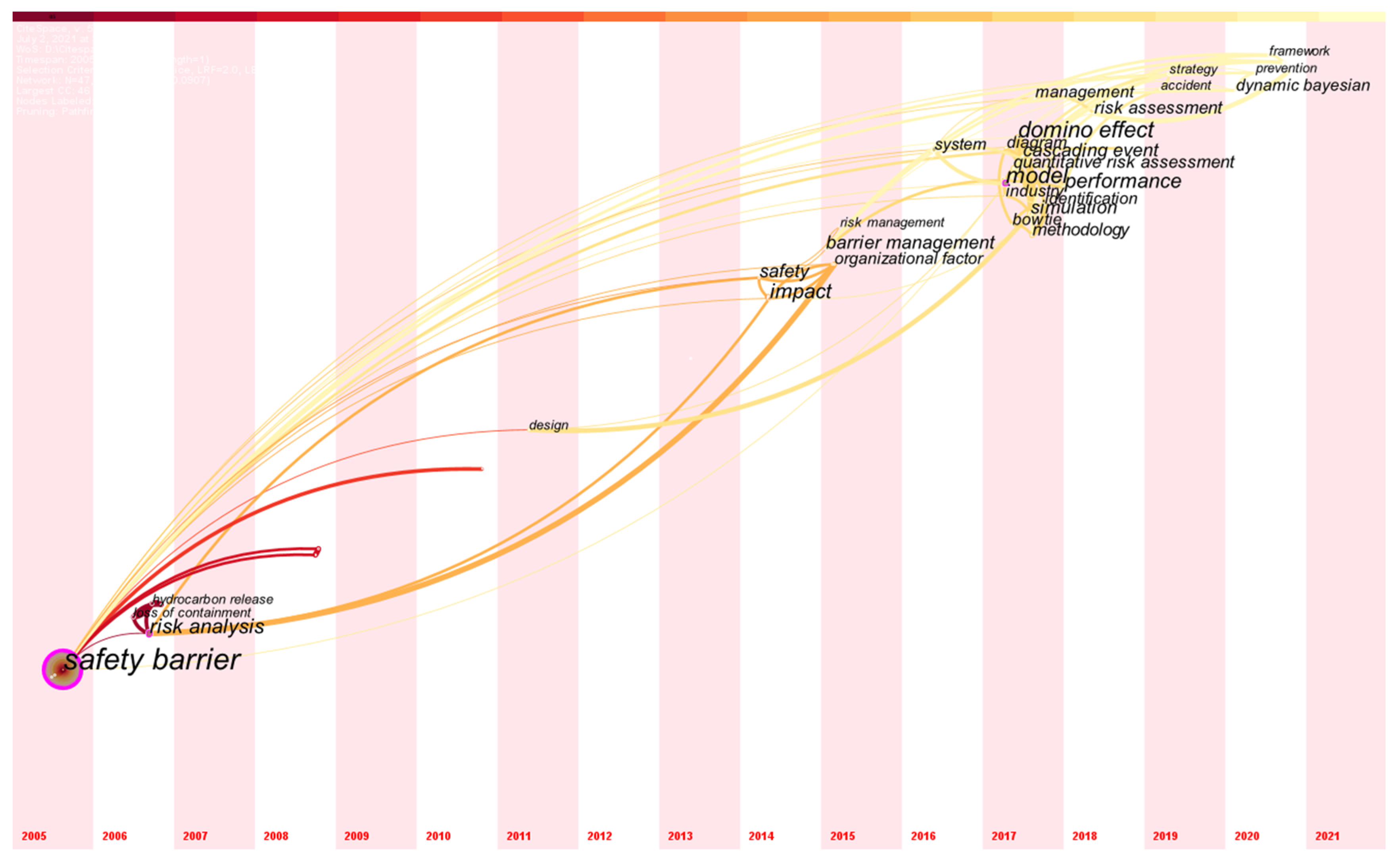

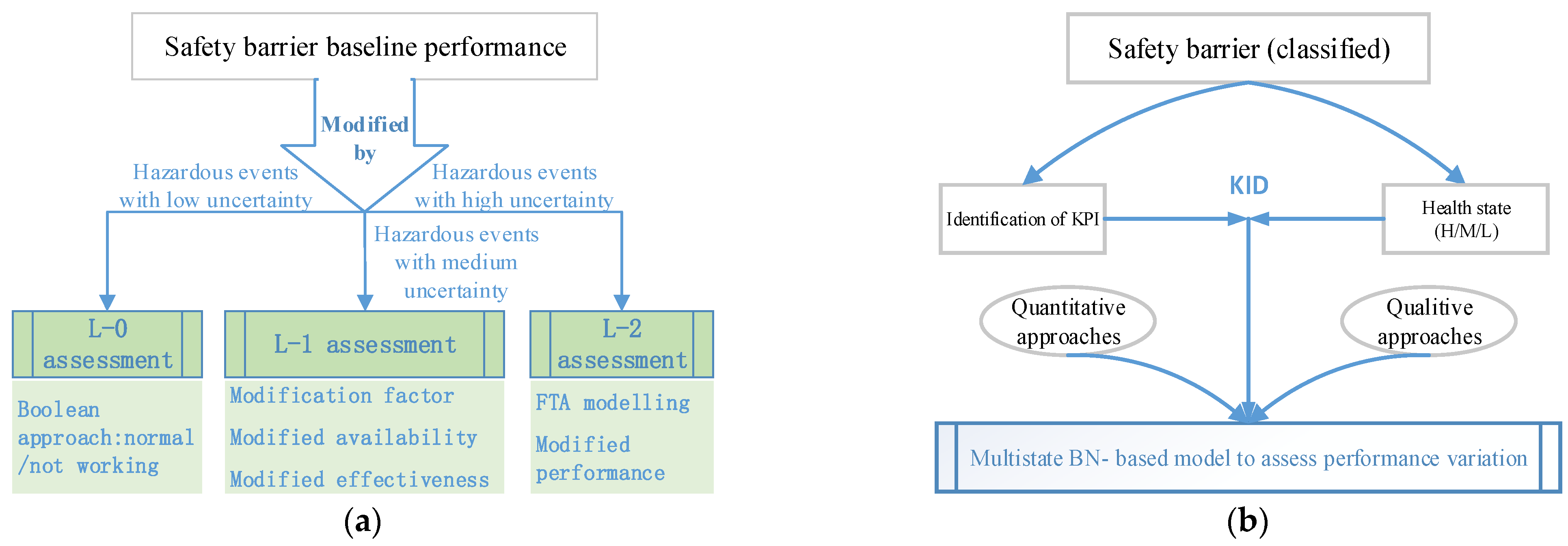

| Subject | Description |
|---|---|
| Databases | Core collection in Web of Science |
| Title keywords | Safety barrier, barrier management |
| Search field | Title, keywords |
| Boolean operation | OR |
| Document type | Research articles |
| Language | English |
| Time interval | 1978–2021.07 |
| Author | Journal | Citations | Application |
|---|---|---|---|
| [9] | JOURNAL OF LOSS PREVENTION IN THE PROCESS INDUSTRIES | 190 | General |
| [37] | JOURNAL OF HAZARDOUS MATERIALS | 126 | Accident prevention |
| [38] | JOURNAL OF HAZARDOUS MATERIALS | 91 | Chemical industry |
| [39] | JOURNAL OF HAZARDOUS MATERIALS | 84 | Accident prevention |
| [34] | RELIABILITY ENGINEERING and SYSTEM SAFETY | 69 | General |
| [40] | PROCESS SAFETY AND ENVIRONMENTAL PROTECTION | 67 | Accident prevention |
| [36] | ENGINEERING FAILURE ANALYSIS | 61 | Road |
| [41] | MATERIALS TESTING | 55 | Road |
| [42] | ENGINEERING FAILURE ANALYSIS | 54 | Road |
| [43] | JOURNAL OF LOSS PREVENTION IN THE PROCESS INDUSTRIES | 53 | Offshore oil and gas |
| Sources | Definition | Industry |
|---|---|---|
| [9] | Safety barriers are physical and/or nonphysical means to prevent, control, or mitigate undesired events or accidents. | General |
| [37] | Safety barriers can be physical and engineered systems or human actions based on specific procedures or administrative controls. | General |
| [34] | Safety barrier is defined as a series of elements dedicated to a certain barrier function where the element can be technical or human-related. | Chemical industry |
| [61] | Safety barrier refers to measures to protect vulnerable assets against hazards posed by failures or deviations of systems. | General |
| [62] | Safety barriers are defined as systems of technical, operational and organizational elements, which individually or collectively reduce the possibility for a specific error, hazard or accident to occur or which limit its harm/disadvantages. | Offshore oil and gas |
| [63] | The safety barrier is designed to reduce the frequency and severity of a top event. | Offshore oil and gas |
| [64] | Safety barriers contain components to protect, mitigate and prevent hazardous sequences of events. | Offshore oil and gas |
| [65] | Safety barrier refers to physical and nonphysical means implemented to reduce the possibility of technological accidents or to lessen their impact | Natech scenario |
| [66] | Safety barrier refers to a system describing the means by which the barrier functions are carried out. | General |
| [67] | The safety barrier is used to describe all aspects associated with safety, such as functions, elements and systems. | Maritime shipping |
| Source | Aspects or Indicators | Industry |
|---|---|---|
| [37] | Effectiveness, response time, level of confidence | General |
| [77] | Effectiveness, reliability, availability | Accident prevention |
| [64] | Effectiveness, degree of confidence, economic impact | Chemical industry |
| [21,76] | Availability (active barrier), effectiveness (passive barriers) | Natech scenarios |
| [62] | Reliability, effectiveness and robustness | Offshore oil and gas |
| [46] | Availability, effectiveness | Offshore oil and gas |
| [66] | Efficiency, resource needs, robustness, availability, independence | General |
| [10] | Availability, probability of failure on demand | Chemical industry |
| Gate Type | Probability Distribution | Graphical Representation |
|---|---|---|
| a | Simple composite probability: the PFD is multiplied by a single probability of the barrier’s success in the prevention of the domino effect. |  |
| b | Composite probability distribution: the PFD is multiplied by a probability distribution expressing the probability of the barrier preventing the domino effect successfully. |  |
| c | Discrete probability distribution: the PFD is multiplied by a discrete probability expressing the probability of the barrier preventing a domino effect in which at least three barriers are involved. |  |
| d | Fragility gate: the output is determined by the objective equipment with the application of equipment vulnerability models. |  |
| Source | Standards or Guidelines | Industry |
|---|---|---|
| [62] | Principles for barrier management in the petroleum industry | Offshore oil and gas |
| [136] | S-001 Technical Safety (Edition 4) | Offshore oil and gas |
| [137] | Guidelines for barrier management in the petroleum industry | Offshore oil and gas |
| [114] | Guidelines for Bow-tie risk management | Chemical industry |
| [115] | Human Factors in Barrier Management | Generic (human-related) |
| [83] | Safety instrumented systems for the process industry sector | Chemical industry |
| [138] | Safety of machinery—Functional safety of safety-related electrical, electronic and programmable electronic control systems | Chemical industry |
| [139] | Road safety barrier systems and devices—Road safety barrier systems | Road transportation |
| [140] | Railway applications—The specification and demonstration of Reliability, Availability, Maintainability and Safety | Railway transportation |
| [141] | Machine Safety—Preventive Fire Protection and Protection | Generic |
| [142] | Petroleum and natural gas industries—Well integrity | Offshore oil and gas |
| [143] | Petroleum and natural gas industries—Drilling and production equipment and subsurface barrier valves and related equipment | Offshore oil and gas |
Publisher’s Note: MDPI stays neutral with regard to jurisdictional claims in published maps and institutional affiliations. |
© 2022 by the authors. Licensee MDPI, Basel, Switzerland. This article is an open access article distributed under the terms and conditions of the Creative Commons Attribution (CC BY) license (https://creativecommons.org/licenses/by/4.0/).
Share and Cite
Qiao, W.; Huang, E.; Guo, H.; Liu, Y.; Ma, X. Barriers Involved in the Safety Management Systems: A Systematic Review of Literature. Int. J. Environ. Res. Public Health 2022, 19, 9512. https://doi.org/10.3390/ijerph19159512
Qiao W, Huang E, Guo H, Liu Y, Ma X. Barriers Involved in the Safety Management Systems: A Systematic Review of Literature. International Journal of Environmental Research and Public Health. 2022; 19(15):9512. https://doi.org/10.3390/ijerph19159512
Chicago/Turabian StyleQiao, Weiliang, Enze Huang, Hongtongyang Guo, Yang Liu, and Xiaoxue Ma. 2022. "Barriers Involved in the Safety Management Systems: A Systematic Review of Literature" International Journal of Environmental Research and Public Health 19, no. 15: 9512. https://doi.org/10.3390/ijerph19159512
APA StyleQiao, W., Huang, E., Guo, H., Liu, Y., & Ma, X. (2022). Barriers Involved in the Safety Management Systems: A Systematic Review of Literature. International Journal of Environmental Research and Public Health, 19(15), 9512. https://doi.org/10.3390/ijerph19159512






